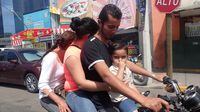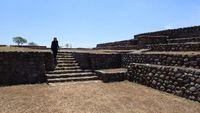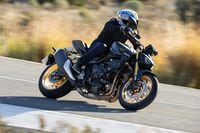Our extra day in Durango quickly turned into almost a week as we made a bunch of new friends while camping out in the courtyard of Tony's restaurant. We spent a day visiting El Viejo Oeste (also known as The Old West), a famous movie set that had been the filming location for well over 150 different westerns over the years, including Big Jake and Chisum, two John Wayne films that had used Chuck Hayward, one of Hollywood's old relatives, as a stunt double (small world!).
We got back to our restaurant camp spot and spent the night partying with Tony and his friends (the Mexican people do not struggle with fiestas!). At the end of the week, we went on a ride down the 40 with Tony and his girlfriend, Giseel, for her birthday, exploring more of the gorgeous mountain roads and pine forests. We eventually stopped at a quaint little restaurant that felt similar to the famous Rock Store nestled in the canyons of L.A.'s Santa Monica Mountains. It was more than I ever could have asked for in terms of hospitality, kindness, and good times. This was the Mexico that I had hoped to be lucky enough to experience. Most of the people we spent time with didn't speak a word of English, yet somehow we spent night after night laughing together, with just enough understanding to have a good time.
As the end of the week came around, it was finally time to part ways. We said our goodbyes, stopping at another of Tony’s restaurants for some sushi plus one last surprise: He had found someone to fix the wire on Hollywood’s Scala Rider headset microphone! We arrived on the mainland with a ton of problems and it felt like all of them had now been solved.
We contemplated taking Highway 23, a road considered one of the most beautiful in the country, but one that was also notorious for drug runners and cartel activity. However, with a strong warning from the locals and no indication of gas stations over the 300-mile stretch, we opted to err on the side of caution and set our route for Zacatecas. The toll road was long but fairly quick amidst fields of vibrant red dirt reminiscent of Canyonlands and Zion, and we arrived in the city by late afternoon. At this point, I think we were both in fairly desperate need of a shower that wasn’t riddled with bugs, so we sprung for a slightly nicer hotel than usual. Zacatecas was a mining city and actually reminded me a bit of the northern outskirts of Salt Lake City in its industrial design. But with nothing of particular interest for us there, we hopped back on the road the next day and made our way toward Guadalajara.
The road to Guadalajara wasn’t any longer than the one to Zacatecas but it twisted and weaved through countless small towns and mountains, so it took probably twice as long to conquer. A large portion of the road was lined with primitive stone walls that appeared to be held together by nothing but gravity and built with probably tens, if not hundreds, of thousands of rocks to create livestock pens and property lines. As poor as road engineering may be in this country, there is certainly no shortage of hard work.
Running later than anticipated due to the complexity of the road, we arrived in Guadalajara only to find a mess of highways and unmarked streets as we attempted to find our hotel for the night. I had heard of Guadalajara but I had no idea of the actual scope of the city; it’s Mexico’s second largest with more than 4 million people! Navigating the streets proved even more frustrating than usual, which is saying a lot for Mexico. I can’t convey strongly enough how much I hate the extreme chaos of traffic flow here. The number of drivers on the road combined with the usual lack of posted street names or directions just compounded the issue. It’s a good thing this city was the birthplace of Tequila and Mariachi, because I definitely needed a drink after that mess.
We’ve had to borderline abandon the notion of camping since getting to the mainland, as the risks of going it in a tent are entirely too high here. Or so I’m told by the locals, who I’m not naïve enough to second guess. This means putting up with the high stress of cities is becoming a requirement, and I think that is really starting to wear on me. Things were so much easier when I could just pitch a tent in any given national forest and only really had to fear bears or getting crickets in my hair.
I put Hollywood in charge of picking the hotel for the next day, and we left bright and early for Colima to try to avoid a little traffic. After all of the twists and turns of yesterday, I actually kind of welcomed the long, straight road in. A perfectly flat and vegetation-less, dried lake bed made up the first half of the ride. It was something different and I really liked it. Double points, of course, for all of the burnouts and donuts and hooligan things that clearly went on there, haha. The second half proved even better, as we rode through mountains, near towering volcanoes.
Now, Colima, I surprisingly really like a lot. An excess of stoplights (as opposed to highly optional stop signs) and a grid-like downtown made it easy to navigate without feeling like I was going to get run over or rammed off the road at any second. We found our hotel with no problem at all which, unbeknownst to either of us, was what’s known as a “hotel de paso” or walk-by hotel that appeared to be largely used by men with their mistresses or prostitutes. This is what happens when I let the dude pick the hotel, haha.
But the rooms were actually really clean and super affordable, room service was inexpensive and delicious (cough there was a ridiculous sex chair and the only channels in English were porn cough) and our bikes were pretty secure. So I actually kind of want to actively seek out these hotels from here on if they're this sweet and cheap.
The best part of all, though, was the location put us only a few kilometers from nearby ruins. On a Monday morning, the ruins of La Campana were completely empty, so we had our run of the place. Clear spring skies meant a perfect view of the massive active volcano in the background. The ruins were estimated to have potentially dated back to as far as 900 BC, according to the plaques. But they admitted to having only explored about 10 percent of the massive network of underground passages, tombs and monuments, so they only knew so much.
We were allowed to walk down the steps to peer inside one of the tombs, where a dog statue protected the dead and helped lead them to the afterlife safely (even the ancient civilizations knew that all dogs go to heaven, haha). I feel like this made my entire trip. Between the irrigation channels and the stairs and tombs of mud, clay and rock, there’s something so awe-inspiring about what humans managed to construct so long before all of the modern tools and equipment we have now.
While a majority of the traffic still scares me, my experience on the mainland is definitely shaping up to everything I could hope for. We’re told it gets a lot more dangerous as we head south toward Michoacán and Guerrero, so we’ll see how it goes from here!










/cloudfront-us-east-1.images.arcpublishing.com/octane/QBAPH5Z5XY26CMNPYRA2FLOCCY.jpg)






/cloudfront-us-east-1.images.arcpublishing.com/octane/OKWOJWAKP5EP3OACCRRWPCIX2Q.jpg)
/cloudfront-us-east-1.images.arcpublishing.com/octane/2WF3SCE3NFBQXLDNJM7KMXA45E.jpg)
/cloudfront-us-east-1.images.arcpublishing.com/octane/G4MG6OUCJNBSHIS2MVVOTPX65E.jpg)
/cloudfront-us-east-1.images.arcpublishing.com/octane/IIGGWFOTOJGB7DB6DGBXCCMTDY.jpg)
/cloudfront-us-east-1.images.arcpublishing.com/octane/QSTCM6AVEZA5JJBUXNIQ3DSOF4.jpg)
/cloudfront-us-east-1.images.arcpublishing.com/octane/U4I7G625B5DMLF2DVIJDFZVV6M.jpg)
/cloudfront-us-east-1.images.arcpublishing.com/octane/B6XD6LS6IVCQPIU6HXDJSM3FHY.jpg)
/cloudfront-us-east-1.images.arcpublishing.com/octane/ICL63FEDDRDTTMINYICCEYGMDA.jpg)
/cloudfront-us-east-1.images.arcpublishing.com/octane/FCGZHQXRBZFLBAPC5SDIQLVF4I.jpg)
/cloudfront-us-east-1.images.arcpublishing.com/octane/WNOB6LDOIFFHJKPSVIWDYUGOPM.jpg)

/cloudfront-us-east-1.images.arcpublishing.com/octane/X33NU3E525ECRHXLNUJN2FTRKI.jpg)
/cloudfront-us-east-1.images.arcpublishing.com/octane/6KKT5NNL2JAVBOXMZYS5ZO76YA.jpg)
/cloudfront-us-east-1.images.arcpublishing.com/octane/J5RKG5O455GMPGQRF2OG6LRT7A.jpg)
/cloudfront-us-east-1.images.arcpublishing.com/octane/GX2CIZKQVRH2TATDM26KFG2DAE.jpg)
/cloudfront-us-east-1.images.arcpublishing.com/octane/ZWIDYSAKQZHD5BHREMQILXJCGM.jpg)
/cloudfront-us-east-1.images.arcpublishing.com/octane/CYUHJZCTSJCH3MRAQEIKXK7SCQ.jpg)
/cloudfront-us-east-1.images.arcpublishing.com/octane/LKOFINY56FCXJCANJ5M7ZDQUBY.jpg)
/cloudfront-us-east-1.images.arcpublishing.com/octane/4NBPDACMWJH63JQYJVK3QRBDZI.jpg)
/cloudfront-us-east-1.images.arcpublishing.com/octane/KKHQHRR3FJGX7H2IPU6RALMWG4.jpg)

/cloudfront-us-east-1.images.arcpublishing.com/octane/5IOFS5JAE5FOXMNA23ZRAVVYUU.jpg)
/cloudfront-us-east-1.images.arcpublishing.com/octane/CGXQ3O2VVJF7PGTYR3QICTLDLM.jpg)
